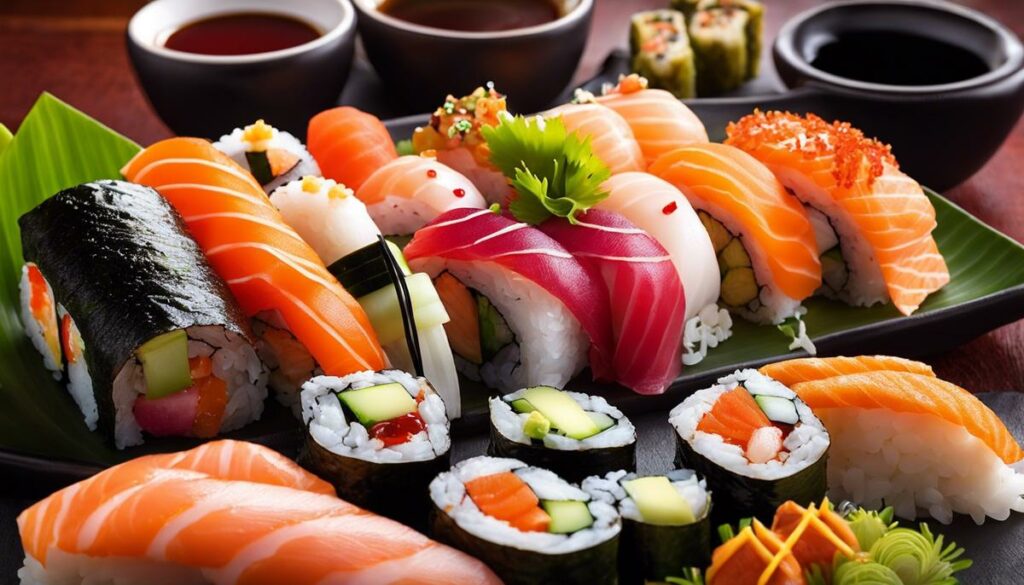Gliding along on a wave of time, Sushi: A Culinary Heritage and Its Future, is a fascinating journey through the centuries, from the simplest forms of food preparation of yesteryear to the global sensation it is today. With its roots deep in Japanese culture, sushi is more than just food – it’s a manifestation of cultural identity and aesthetics, a culinary delight that engages the senses with every bite.
The history of sushi is an impressive testimony to the transformation – from its beginnings in the Edo period, to the adjustments made during the Meiji era, to today’s popular culture. In addition, sushi weaves seamlessly with fashion and aesthetics, a visual icon in art, design, and social media. With countless variations and styles, sushi is a living example of how tradition and innovation can flow together in harmony.
A fundamental requirement for the preparation of sushi is the finest ingredients. It’s not just about freshness and quality, but also about sustainability and seasonality. From the choice of fish to the choice of wasabi, from the grain of the rice to the soy sauce, every detail plays an important role in the enjoyment of sushi.
The History of Sushi
The charm of sushi: a journey through the centuries
When culinary delights and art come together, the result is often sushi. This piece of luck is probably the best-known representative of Japanese cuisine. However, sushi also has an impressive history that spans centuries and continents, and from this it has divided its position in global cuisine.
Sushi – the beginnings
The first references to sushi take us way back to the 8th century. Originally developed as a method of preserving fish, however, the original sushi looked a little different and was called nare sushi. Raw fish was placed in rice and left to ferment – after several months, the fish was ready to eat while the rice was disposed of.
Sushi – The Evolution
In the 16th century, however, it was recognized that the rice used during production was also edible and even tasty. As a result, the so-called ‘hana-zushi’ was created, whereby the fish was no longer fermented for months, but pickled in vinegar and served together with rice.
Sushi’s big breakthrough came in the 18th century. A chef named Hanaya Yohei opened the first Edo-style sushi stand in Tokyo. This variant of sushi, in which marinated fish fillet is placed on vinegar rice, was quick, easy to handle and ideal for the fast-paced urban population.
Sushi – An excursion into the modern age
In the 20th century, globalization finally put sushi on the international menu. Sushi is particularly popular in the United States, where the first sushi restaurant outside Japan opened in 1966.
This triumph led to the development of new varieties of sushi, of which the California Roll is probably the best known. Characterized by an outer roll with rice and a filling of surimi (imitation crab meat), avocado and cucumber, this creation has revolutionized the sushi world and opened new doors for creative interpretations of the traditional dish.
Today, sushi is an integral part of the global gastro scene. It stands for healthy enjoyment as well as aesthetics and the opportunity to cross culinary-creative boundaries.
And even though traditional sushi consists only of rice, fish and a few other ingredients, its journey through the centuries shows that behind its simplicity lies an enormous capacity for innovation and adaptability. Thus, the magical world of sushi radiates exactly the essence that can be found in every successful creative task – simplicity as the highest form of sophistication.
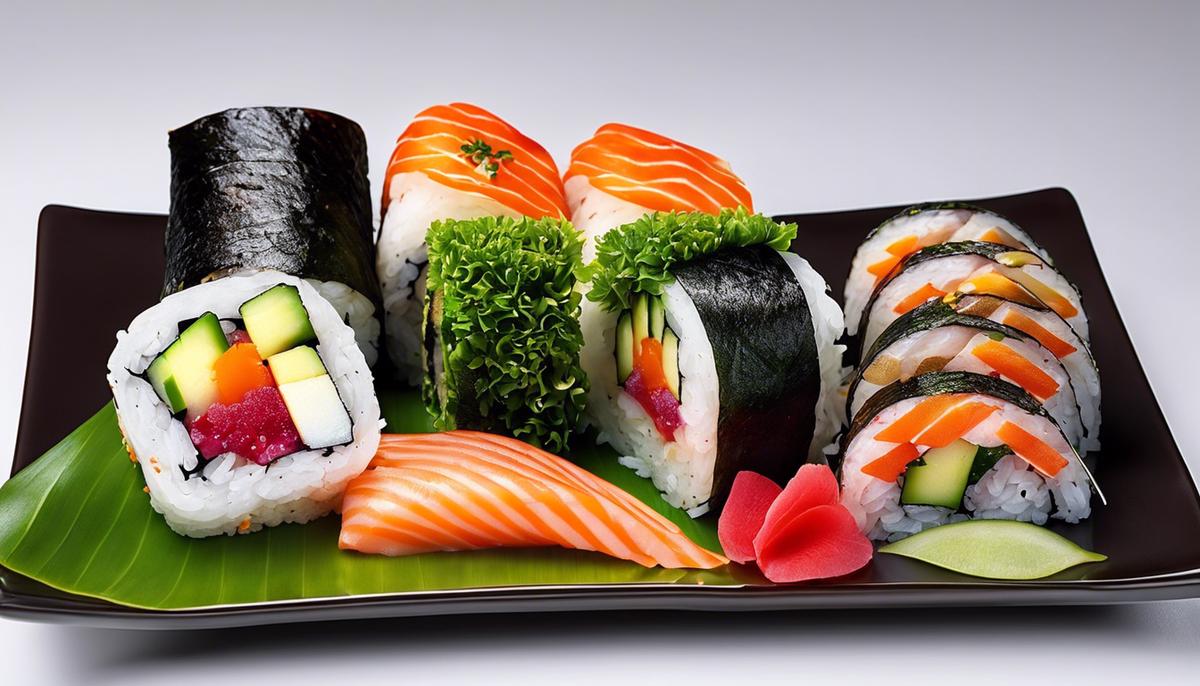
Sushi in the context of fashion and aesthetics
The visual presentation of food has proven to be crucial in conveying taste and quality. The aesthetic of sushi has undoubtedly contributed to its worldwide popularity and acceptance, especially in the modern, fashion-conscious society. The colorful depiction of sushi is as intriguing as it is appetizing, and plays a significant role in the social media landscape. There’s no denying that the presentation, staging, and reproduction of sushi on platforms like Instagram has contributed to the popularity of this Japanese dish.
Sushi’s attractive appearance, coupled with its healthy component, has made it a favorite among health and fitness fanatics. It appeals to those who pay special attention to their physical appearances and showcase their lifestyle in terms of fashion, health, and aesthetics. It’s no surprise that sushi regularly appears on lifestyle influencers’ profile pages.
In addition, sushi is versatile and adaptable, qualities that are highly valued in our fast-paced, fashion-conscious society. Whether it’s vegan sushi, superfood sushi, or dessert sushi, creativity knows no bounds, and this variety appeals to a wide range of flavors. So it shows that sushi is more than just a dish – it’s a way of expressing yourself and showing individuality.
Coupled with the culinary delight that sushi provides, its aesthetics have become a strong selling point. You could say that it is an art form that appeals to the senses, in the truest sense of the word, “edible art”. It combines craftsmanship, beauty and nutrition, making it a sought-after object of desire.
To sum it up, the popularity and acceptance of sushi in modern fashion-conscious society is no coincidence. The successful fusion of aesthetics, fashion, health awareness and cultural exchange is what has secured sushi its enduring place on our plates and in our social media feeds. In a connected world where image and brand are everything, sushi embodies both a visual delight and a taste of exquisiteness.
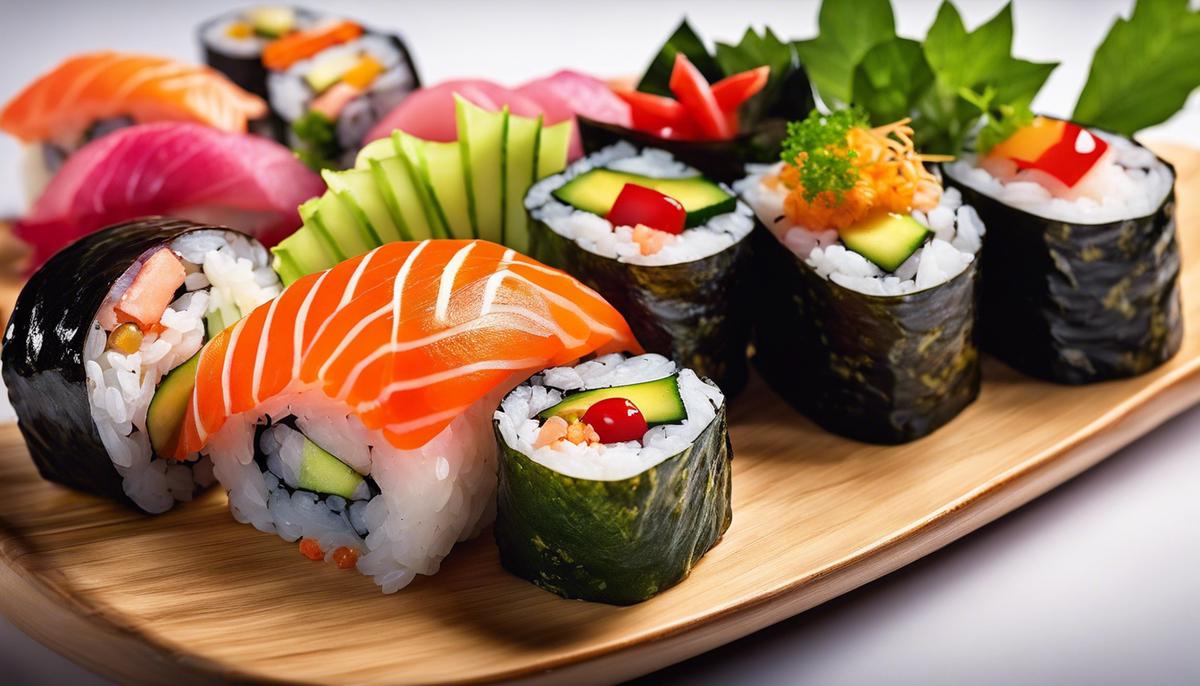
The importance of high-quality ingredients in sushi preparation
Sushi isn’t just a culinary art, it’s an art form. It shows us that tasty food doesn’t have to be excessively complex. But what makes the real sushi enjoyment? The answer lies in the quality of the ingredients.
The importance of high-quality fresh produce in sushi production cannot be overstated. Sushi masters often mention that they check the quality control of the ingredients, such as the fish, down to the minute. Even a slight variation in freshness or quality can affect the taste and texture of the sushi roll.
Let’s look at the fish, one of the main ingredients in sushi. The decisive factor here is absolute freshness. Ideally, fish should be processed on the day of the catch. Whether it’s tuna, salmon, mackerel or yellow swordfish, the freshness of the fish gives sushi its characteristic, unmistakable taste.
But it’s not just the fish products, the other ingredients also play a crucial role. Rice is the foundation of every piece of sushi. It is important that the rice is washed, cooked and seasoned correctly. From handmade sushi to industrial production, a good rice is essential.
Not to be forgotten is the nori, the dried seaweed sheet used for many sushi rolls. Quality nori has a deep green color, crisp texture and a distinct taste.
The soy sauce, traditionally served in small bowls, also has an enormous influence on the overall impression of sushi. A premium soy sauce is usually naturally brewed and has a wonderful balance between salty and sweet that completes a sushi dish.
And can we forget the wasabi? This green, spicy horseradish is a necessary addition to flavor the sushi dish, but only in small quantities so as not to overpower the delicate flavor of the fish.
The final conclusion remains: When it comes to sushi, it’s all about the details. A combination of high-quality, fresh ingredients and the exquisite artistry of the sushi master are the secret to the fantastic taste. Sushi remains a sought-after specialty, not only for its deliciousness, but also for its unique aesthetic and the deep-rooted tradition that is revealed in each piece.
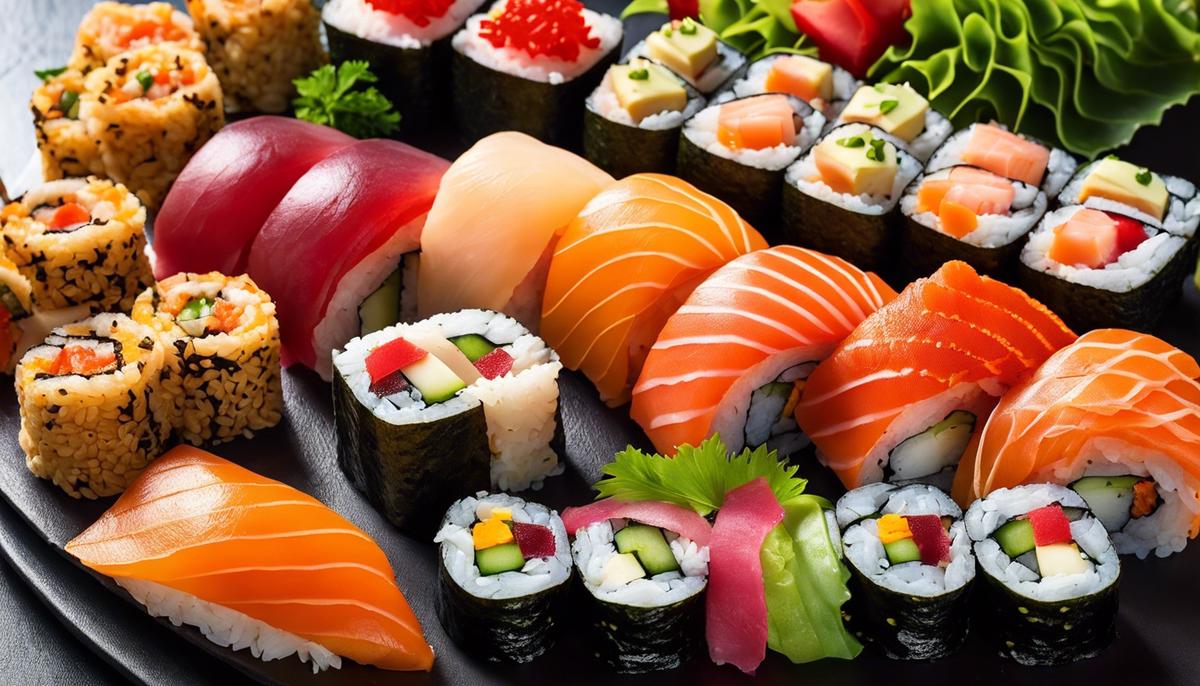
The Future of Sushi
Future of Sushi: Re-examining the Course in the Face of Global and Environmental Challenges.
The remarkable development and adaptability of sushi will continue to allow it to meet global culinary trends and environmental challenges in the future. With the growing awareness of the environment and sustainable action, it is to be expected that changes will take place in the preparation of sushi to contribute to a more sustainable gastro scene.
In the future, the use of sustainably caught fish and seafood could play a decisive role. Sushi creations with alternatives to endangered species such as bluefin tuna could enrich the menus. The choice of seasonal and locally available ingredients to minimize the CO2 footprint of the products used could also become increasingly important.
In addition, the trend towards plant-based diets could have an influence on sushi creations. Vegetarian and vegan sushi are becoming more and more popular and offer an interesting way to enjoy sushi without eating seafood, even for sustainability-conscious and health-oriented people.
In addition, increased use of organic ingredients, such as organic rice, organic nori, and organic soy sauce, would contribute not only to sustainability but also to the health of consumers.
Waste reduction is another important aspect that could be incorporated into the future of sushi. This could be achieved through the conscious use of packaging, but also through innovative preparation methods aimed at minimizing food waste.
Sushi has proven its versatility in the past, and it’s exciting to see how sushi will continue to respond to global culinary trends and environmental challenges. It is clear that not only does sushi continue to be one of the most representative dishes of Japanese gastronomy, but it is also constantly evolving to meet the changing demands and preferences of the global gastro scene. Sushi is and will always be a culinary work of art with a deep-rooted tradition, but still in constant flux.
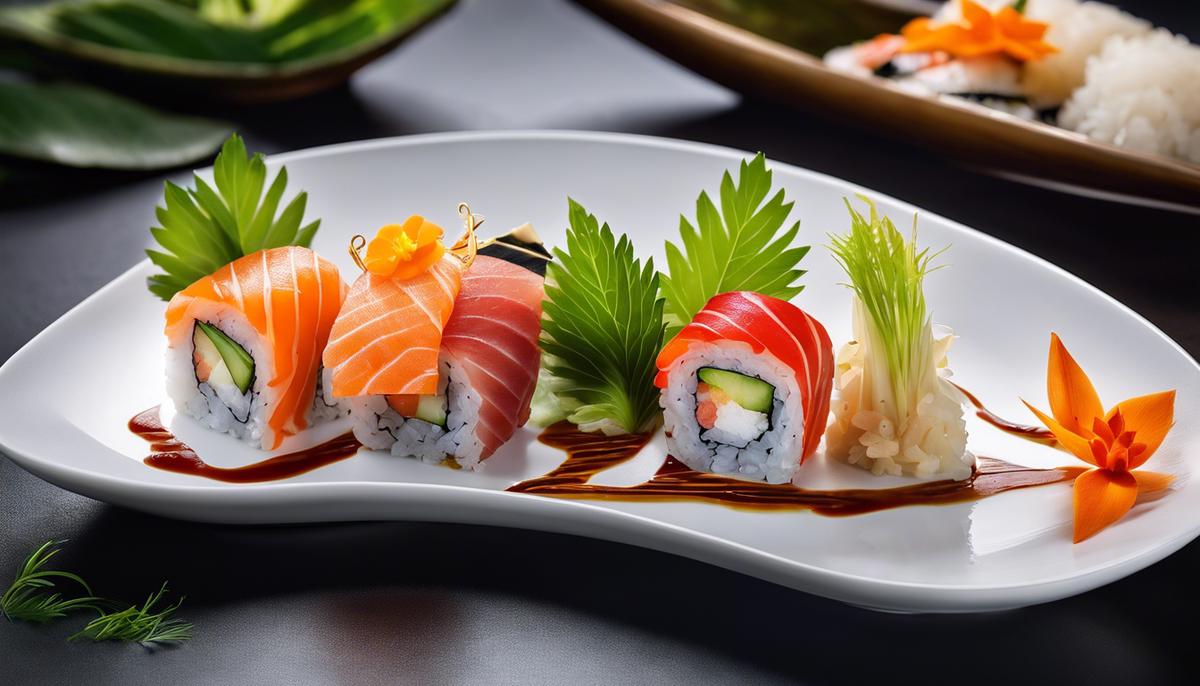
As times change and new trends emerge, it is clear that sushi will continue to play a central role in the culinary world. With a growing awareness of eco-friendly practices and a continuous search for new flavor combinations, the future of sushi may seem even brighter than we can imagine.
Innovations and culinary experimentation could redefine the traditional sushi experience and keep it relevant for future generations. But no matter how sushi evolves, it will always remain a symbol of Japanese culture and culinary heritage, a delight that touches the senses with every bite.
